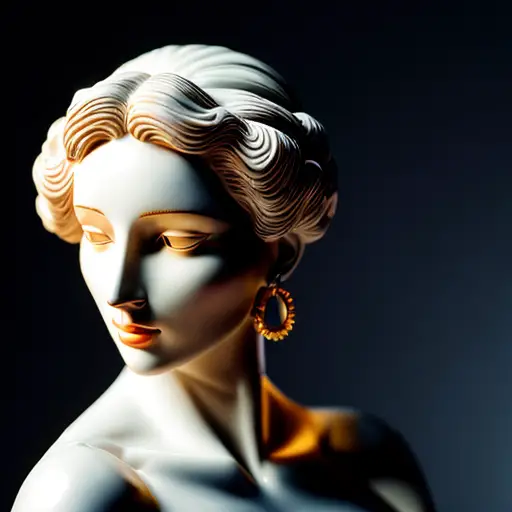Welcome, dear readers, to the whimsical world of Baroque sculpture! Prepare to be dazzled and amused as we delve into the peculiarities that set this artistic style apart from its classical counterpart. Picture this: while classical sculptures exude a sense of calm and serenity, Baroque sculptures are like the life of the party, bursting with drama and flamboyance. Gone are the days of stoic poses and restrained emotions; Baroque artists embraced the notion of 'go big or go home.' Think exaggerated gestures, swirling drapery, and an abundance of intricate details that make you wonder if the sculptor had an unlimited supply of patience (or perhaps a touch of madness). So, grab your popcorn and get ready to witness the unveiling of the distinctive characteristics that make Baroque sculpture a delightful feast for the eyes!
An interesting fact about how Baroque sculpture is different from classical sculpture is that while classical sculpture aimed to depict idealized and perfect human forms, Baroque sculpture embraced a more dynamic and emotional approach. Baroque sculptors sought to capture movement, drama, and intense expressions, often portraying figures in highly theatrical and exaggerated poses. This departure from the serene and balanced compositions of classical sculpture allowed Baroque artists to convey a sense of energy, passion, and realism, making their works more emotionally engaging and captivating to viewers.
Step into the enchanting world of classical sculpture, where time seems to stand still and beauty knows no bounds. Unlike its flamboyant Baroque counterpart, classical sculpture exudes an air of tranquility and grace. Imagine strolling through a museum, encountering statues that embody the idealized human form, frozen in eternal perfection. The classical sculptors, inspired by the gods and goddesses of ancient Greece and Rome, sought to capture the essence of harmony and balance. Every curve, every muscle, meticulously crafted to create a sense of serenity and timelessness. So, let us embark on a journey through the ages, where the beauty of antiquity awaits to captivate our hearts and minds.

Welcome, dear readers, to the exhilarating world of the Baroque Revolution! Brace yourselves for a journey through time as we explore the dynamic and dramatic elements that set Baroque sculpture apart from its classical predecessor. In the realm of Baroque, prepare to bid farewell to the serene and stoic poses of classical sculpture, and instead, embrace a whirlwind of emotion and movement. Baroque sculptors dared to challenge the norms, infusing their works with a sense of theatricality that leaves viewers in awe. Gone are the days of perfectly proportioned figures; Baroque sculptures are characterized by exaggerated gestures, contorted poses, and an explosion of energy that seems to leap off the pedestal.
One cannot help but marvel at the intricate details that adorn Baroque sculptures. While classical sculptures aimed for simplicity and idealized beauty, Baroque artists reveled in the ornate and extravagant. Every crease in a garment, every strand of hair, meticulously carved to create a sense of opulence and grandeur. Baroque sculptures are a feast for the eyes, with cascading drapery, intricate textures, and a level of realism that makes you question if the marble or bronze has come to life.
But perhaps the most striking difference between Baroque and classical sculpture lies in the emotions they evoke. While classical sculptures exude a sense of calm and serenity, Baroque sculptures are unapologetically passionate and dramatic. The figures seem to be caught in a moment of intense emotion, their faces contorted with anguish or ecstasy. Baroque artists sought to elicit a visceral response from viewers, to stir their souls and leave them breathless. It is this raw and unfiltered expression of human emotion that sets Baroque sculpture apart, forever etching its place in the annals of art history.
So, dear readers, prepare to be swept away by the Baroque Revolution, where dynamic poses, intricate details, and intense emotions collide to create a truly mesmerizing experience. Let us revel in the audacity and brilliance of the Baroque sculptors, who dared to challenge the norms and create a visual spectacle that continues to captivate audiences to this day.
A fun fact about how baroque sculpture is different from classical sculpture is that while classical sculptures aimed for idealized and harmonious representations of the human form, baroque sculptures embraced drama and dynamism. Baroque sculptors often depicted figures in exaggerated poses, with flowing drapery and intricate details, creating a sense of movement and emotion. This departure from the classical norms allowed baroque sculptures to convey intense narratives and engage viewers in a more theatrical and captivating way.
In the vast realm of art history, few styles stand in starker contrast than Baroque and classical sculpture. While classical sculpture embodies a sense of harmony and idealized beauty, Baroque sculpture embraces the dramatic and dynamic. Classical sculptures exude a serene calmness, with figures frozen in timeless perfection, while Baroque sculptures burst forth with energy and emotion, capturing the essence of human passion. The attention to detail in classical sculpture is refined and restrained, while Baroque sculptures revel in ornate intricacies that leave viewers in awe. These contrasting styles offer a captivating glimpse into the evolution of artistic expression, showcasing the boundless creativity and diversity of human imagination.